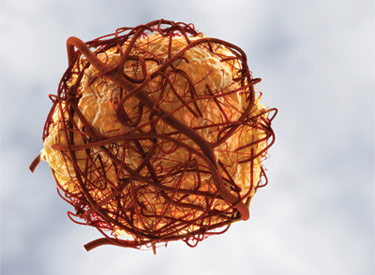CST signaling pathway diagrams allow you to click on individual nodes to find research resources or product information. You can also download the pathway diagrams for educational and research purposes.

Angiogenesis is the formation of new blood vessels from pre-existing blood vessels. Angiogenesis is important for new blood vessel and capillary growth during development, wound healing, female reproduction, and tumor growth. When angiogenesis is stimulated, pro-angiogenic growth factors such as VEGF, PDGF, FGF, and TGF are released. These growth factors bind their cognate receptors on endothelial cells (EC) within pre-existing vessels. This triggers a signaling cascade that activates several signaling pathways such as PI3K/Akt, Erk1/2, Smad, and Notch and results in EC proliferation and migration. New blood vessel formation occurs as ECs use matrix metalloproteases (MMPs) and integrins to digest extracellular matrix and migrate into new territory where they lengthen and form tubes.
Pericytes are support cells that provide structural stability for newly formed blood vessels, promote endothelial cell survival, guide sprouting vessels, and regulate vasoconstriction and dilation. This is done through a reciprocal signaling mechanism in which PDGF-BB secreted into the matrix by endothelial cells acts as a ligand for PDGFR-β located on the pericyte membrane. In return, pericytes produce and secrete VEGF that signals through the endothelial VEGF receptor.
Tumor angiogenesis occurs when cancer cells stimulate new blood vessel growth in order to bring oxygen and nutrients to a tumor. As a tumor grows in size, diffusion is no longer sufficient to oxygenate the cells at the center of the mass, creating a hypoxic environment. Hypoxia stabilizes the expression of HIF-1α, a transcription factor that responds to changing oxygen levels. Under hypoxic conditions, HIF-1α binds HIF-1β to activate transcription of angiogenesis-promoting genes. Cancer cells also secrete a variety of growth factors and cytokines that stimulate classical angiogenic signaling pathways, extracellular matrix remodeling, and an inflammatory response that leads to new blood vessel formation. Extensive research continues on anti-angiogenic therapies that combat cancer by preventing access to the blood supply that is critical for tumor growth and survival.